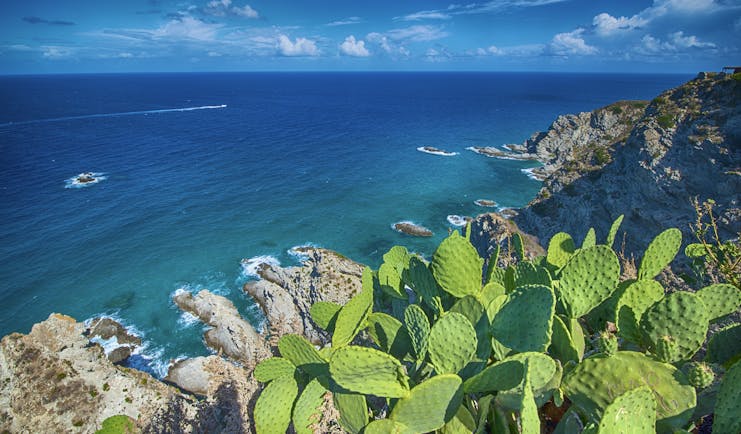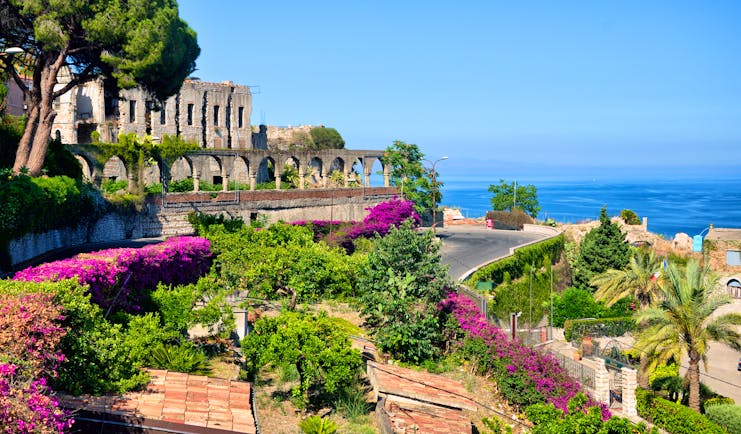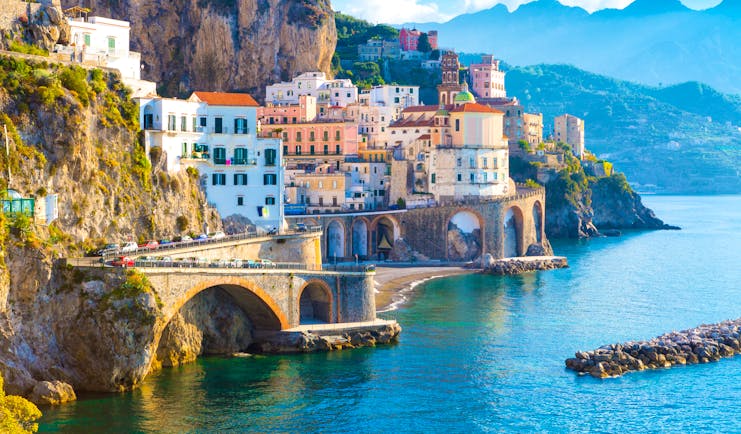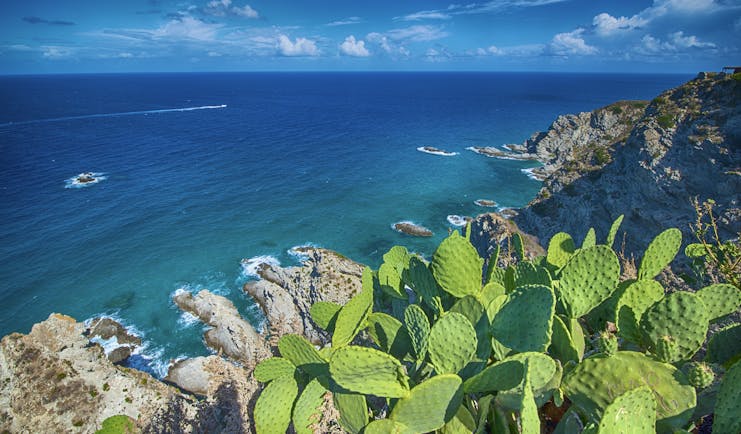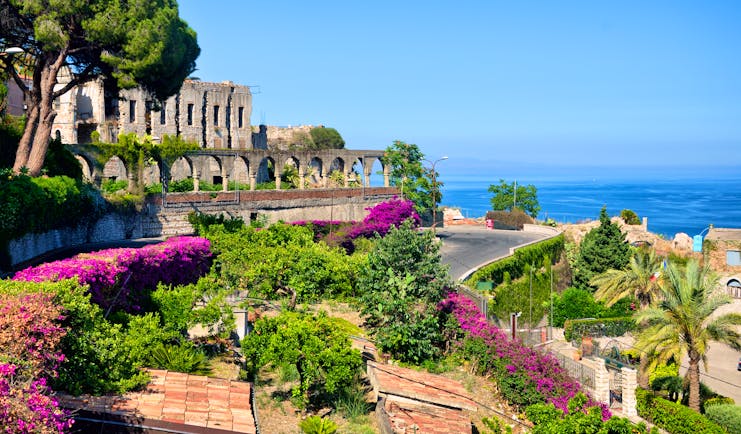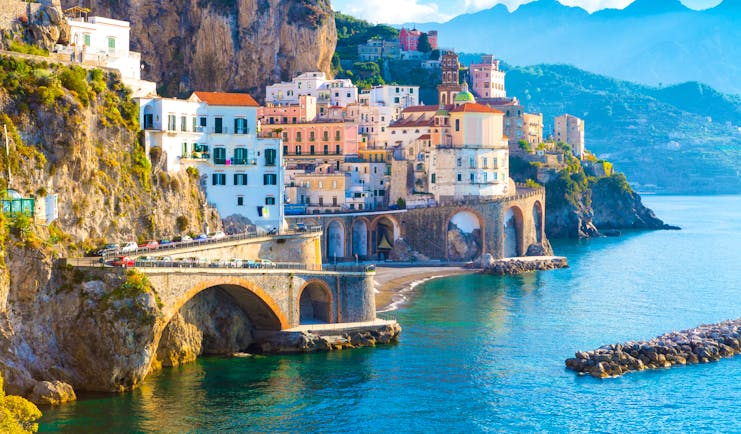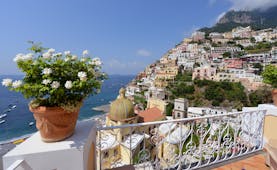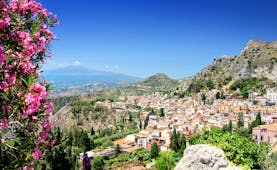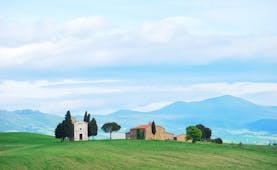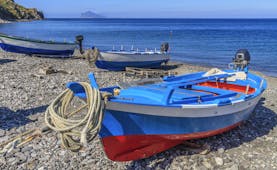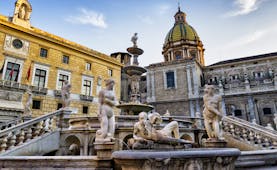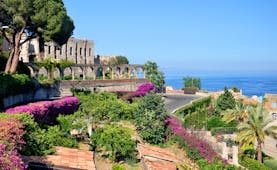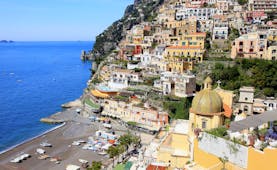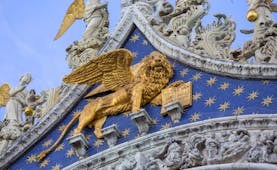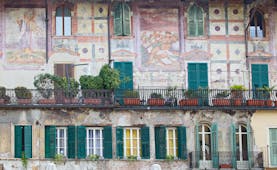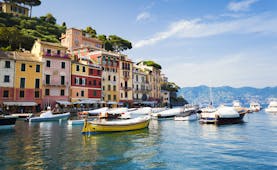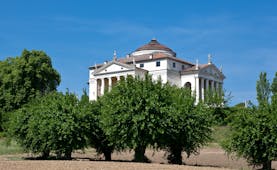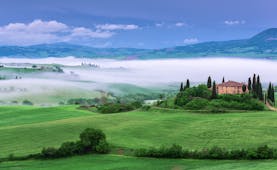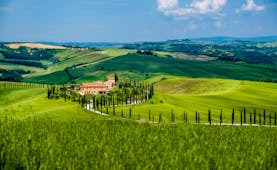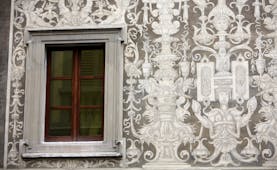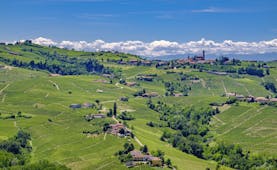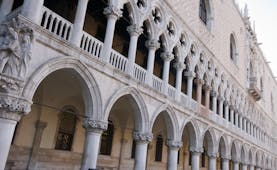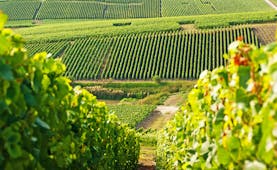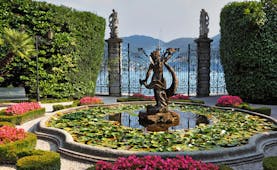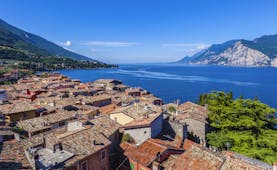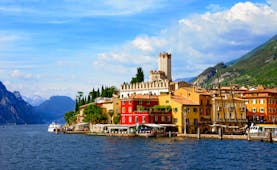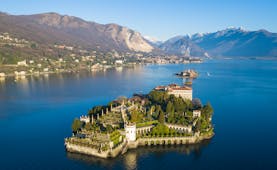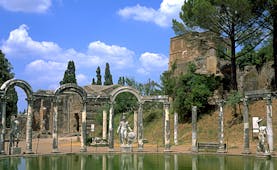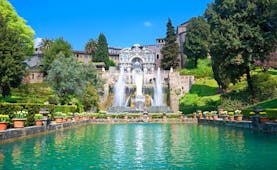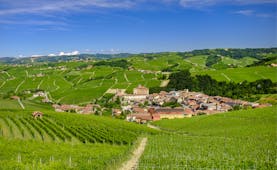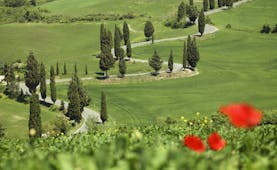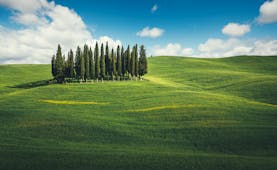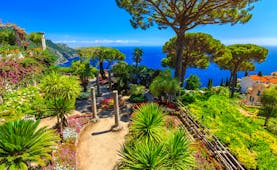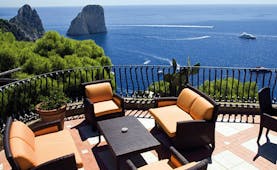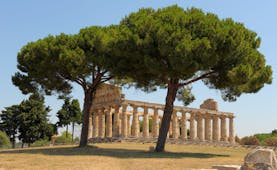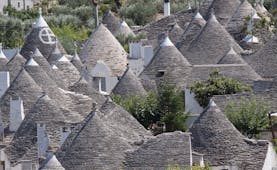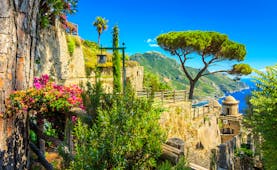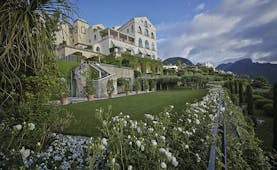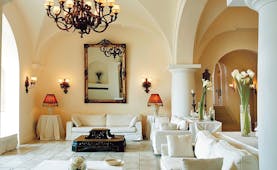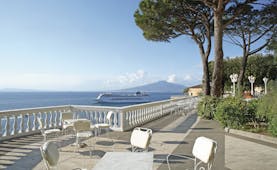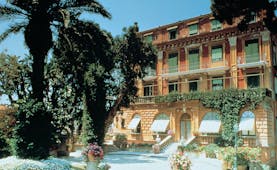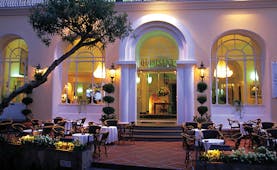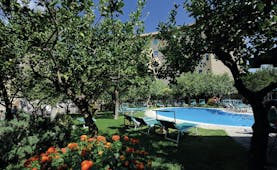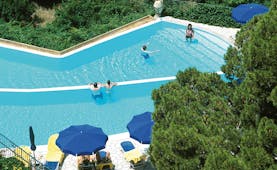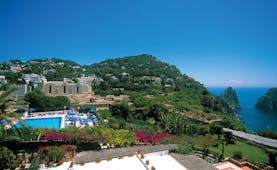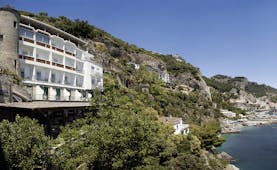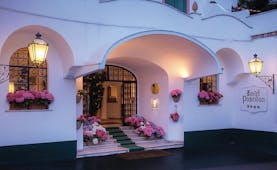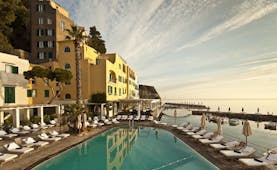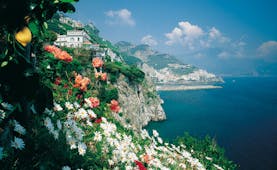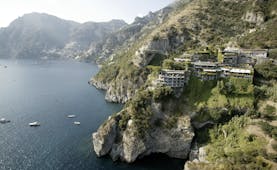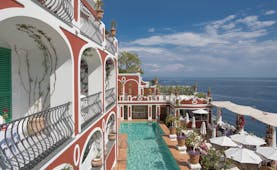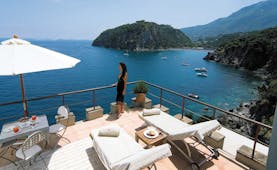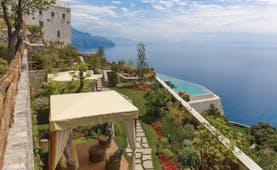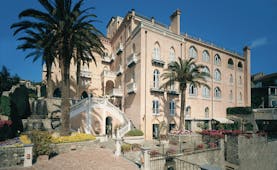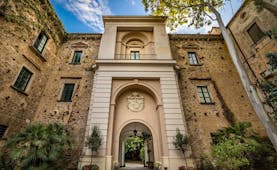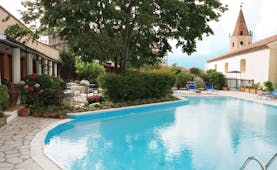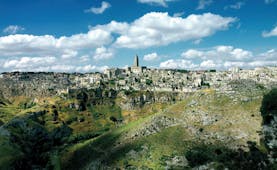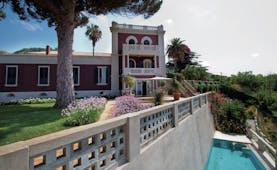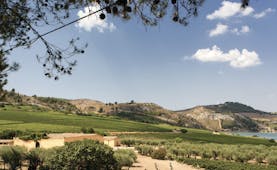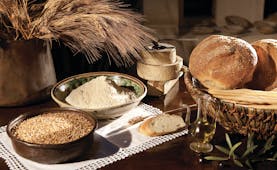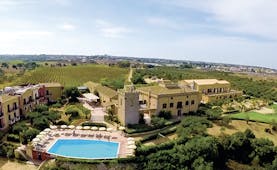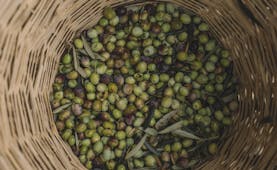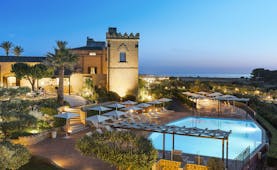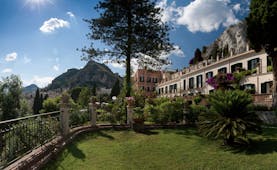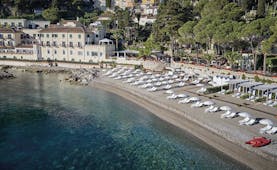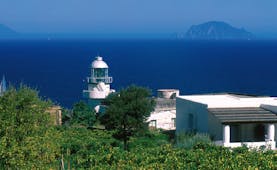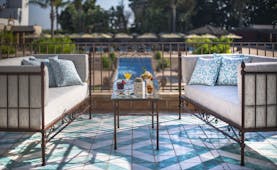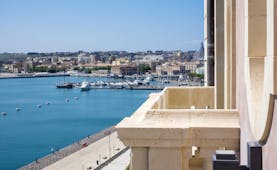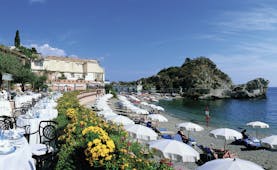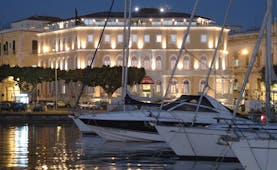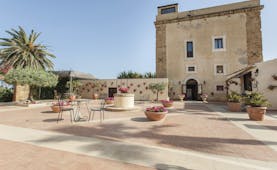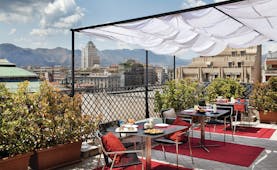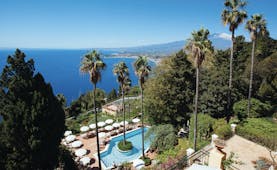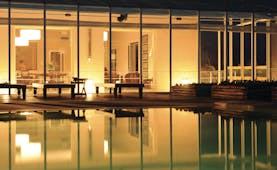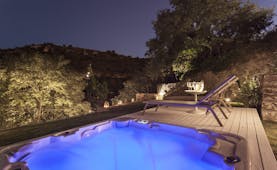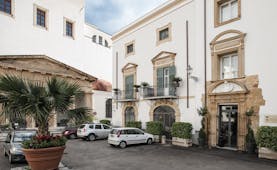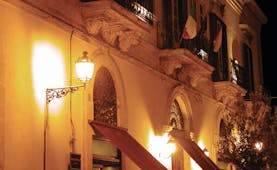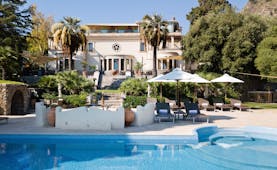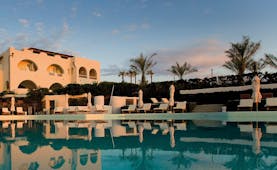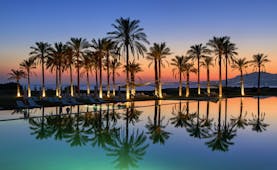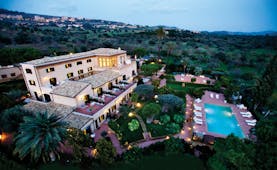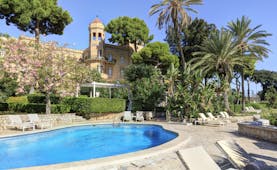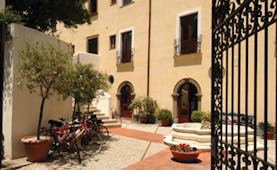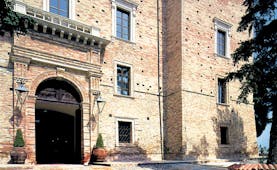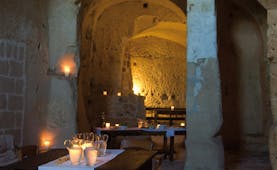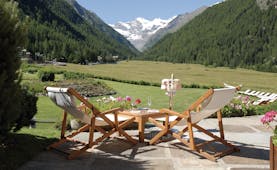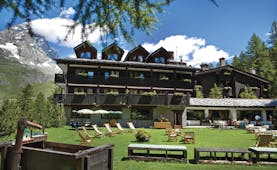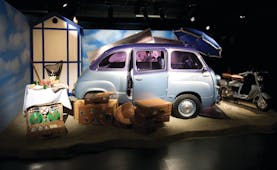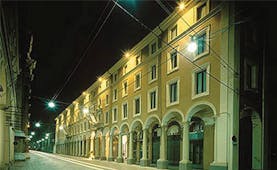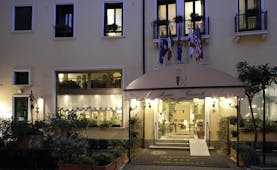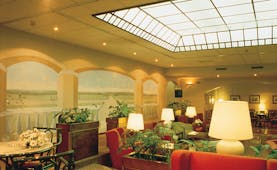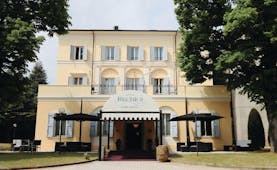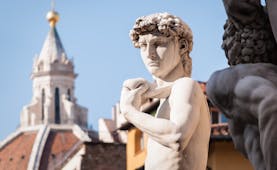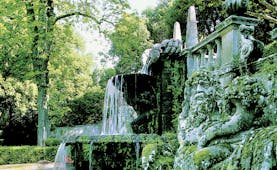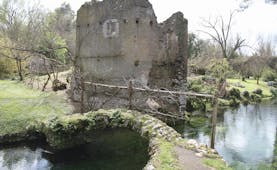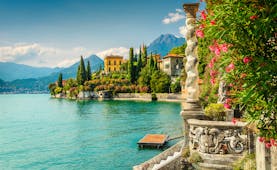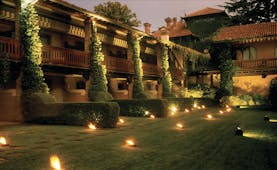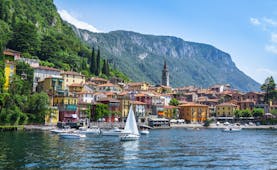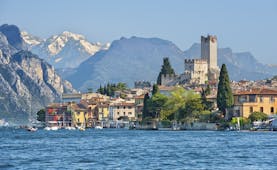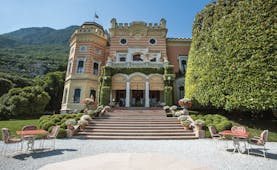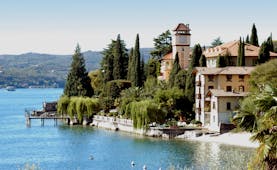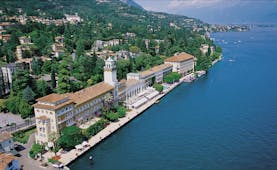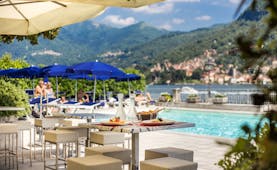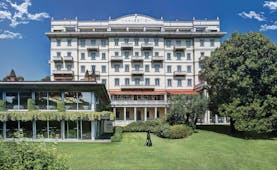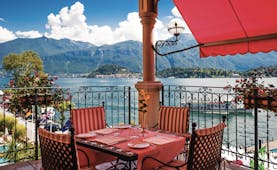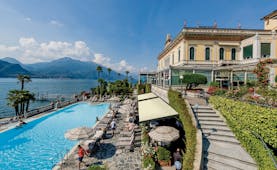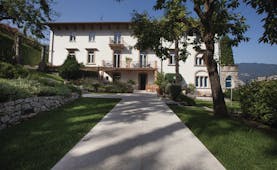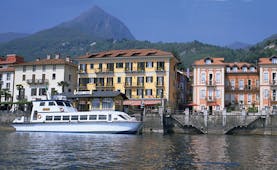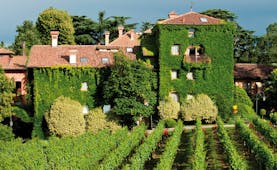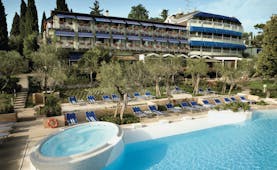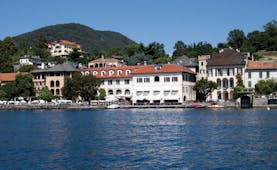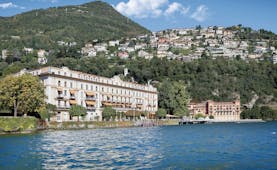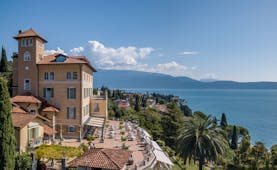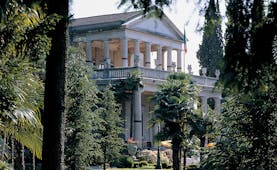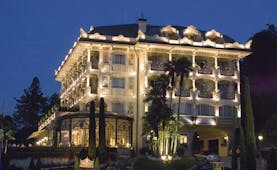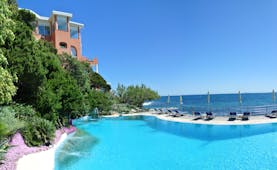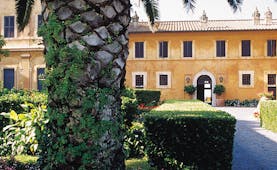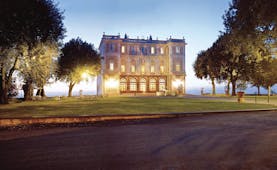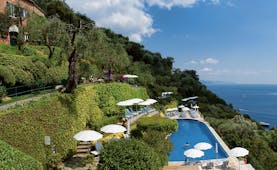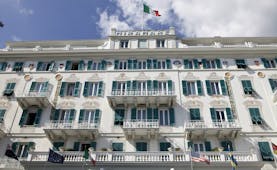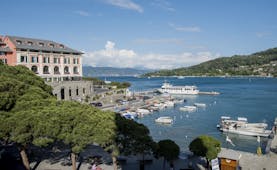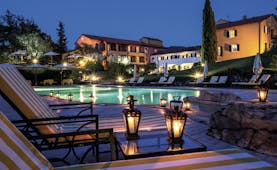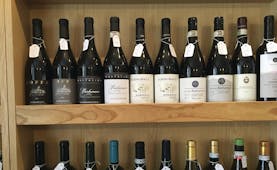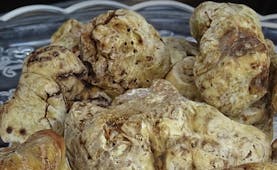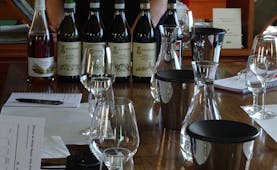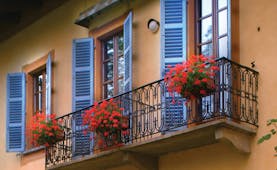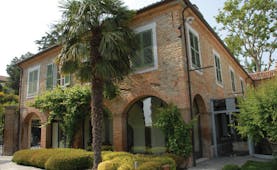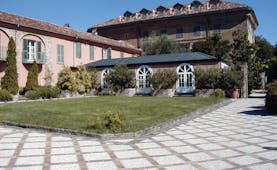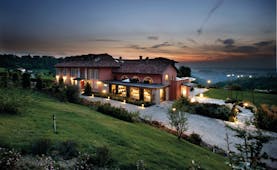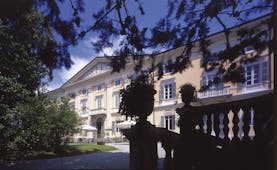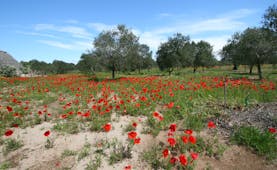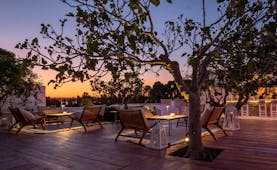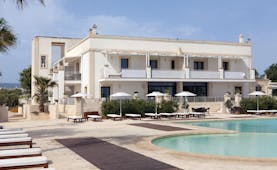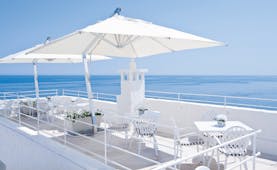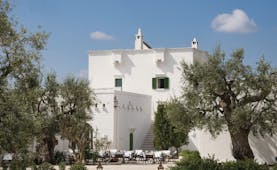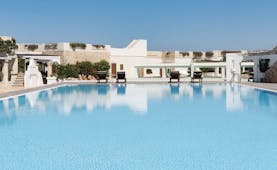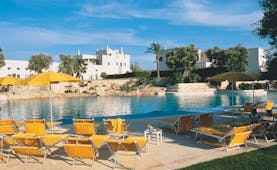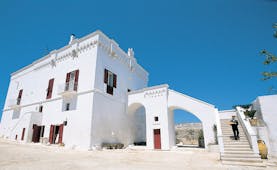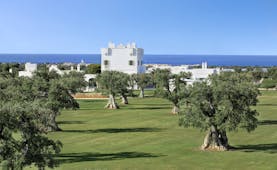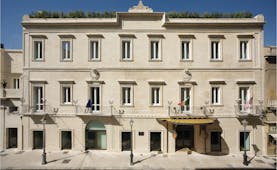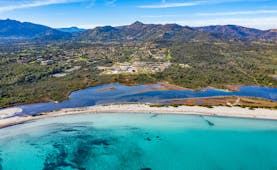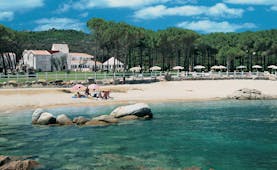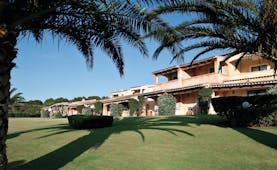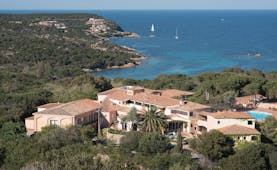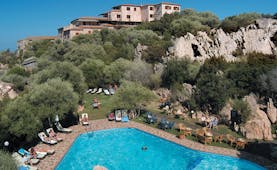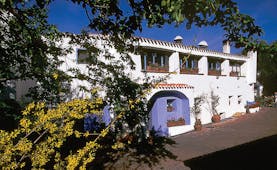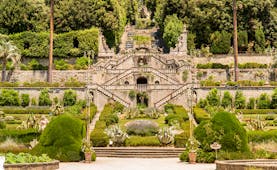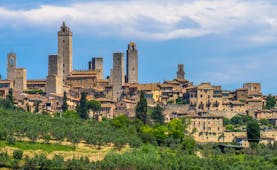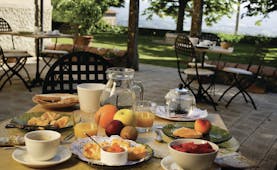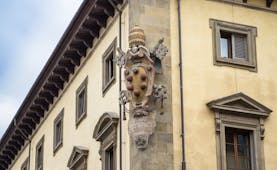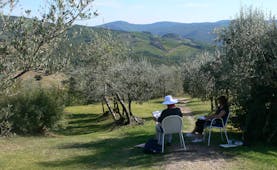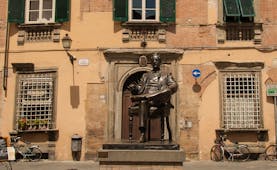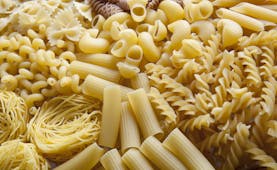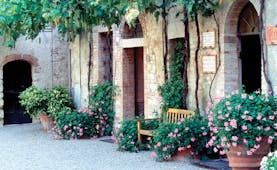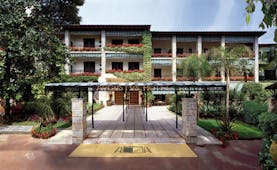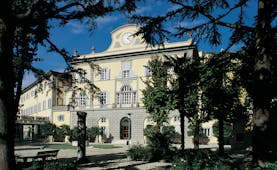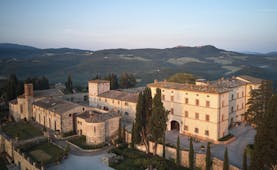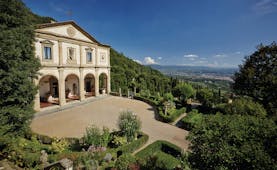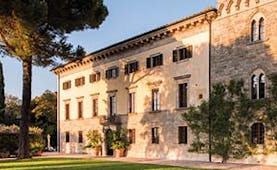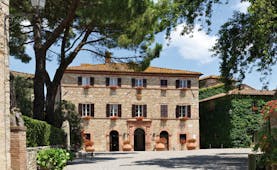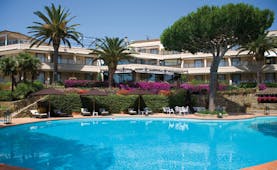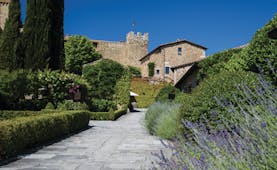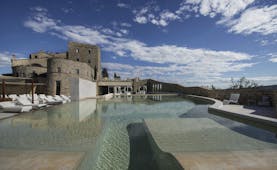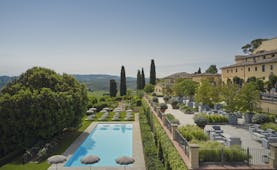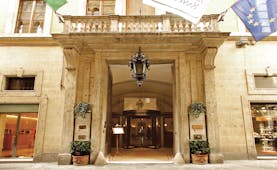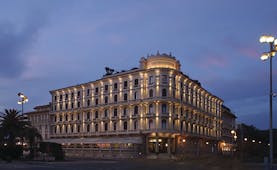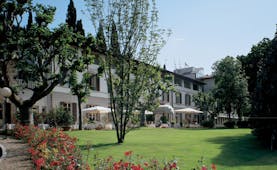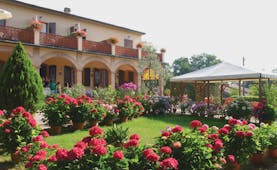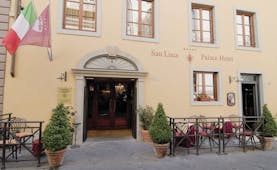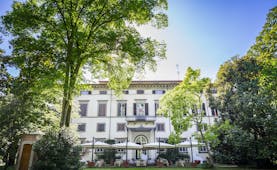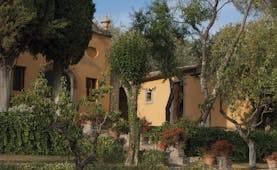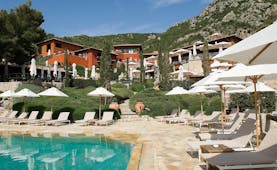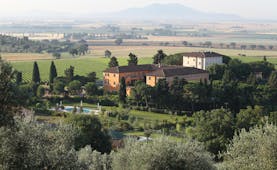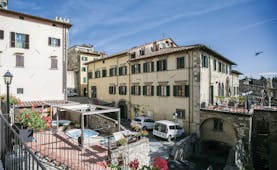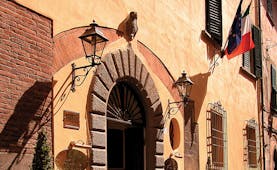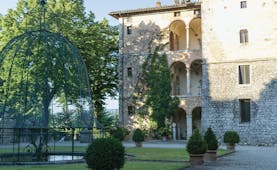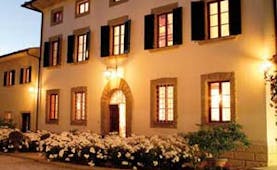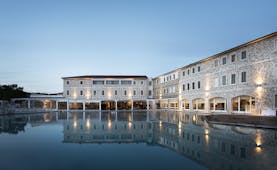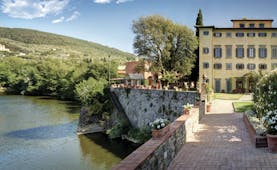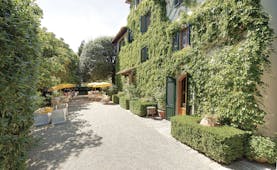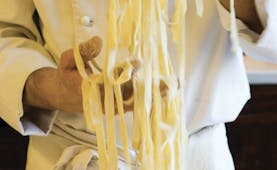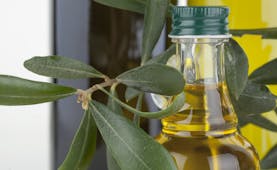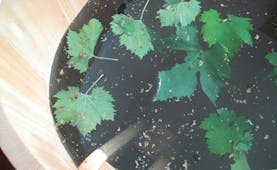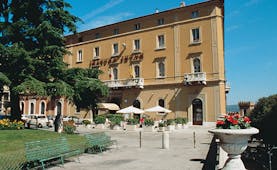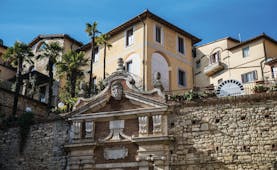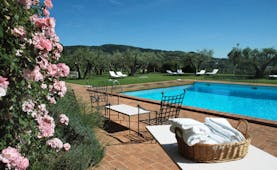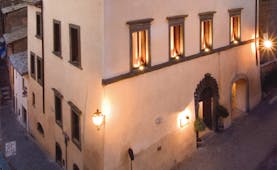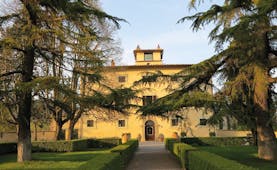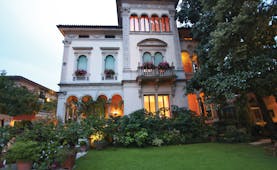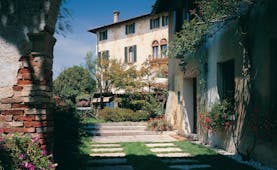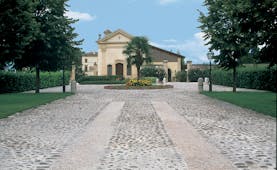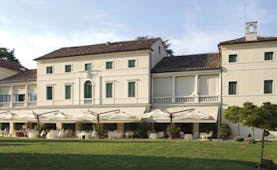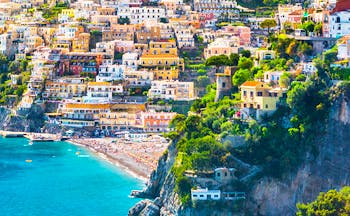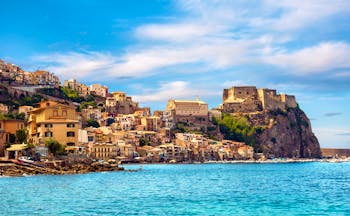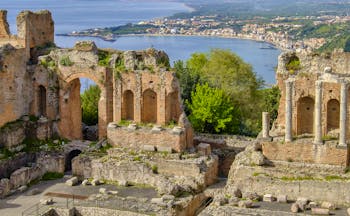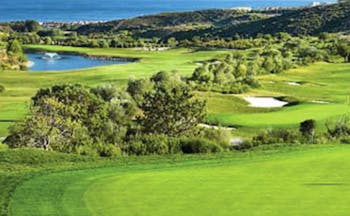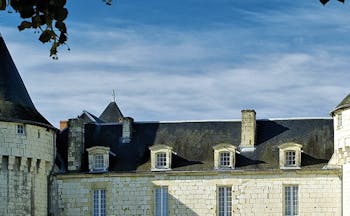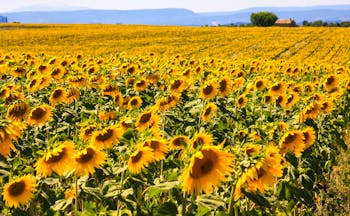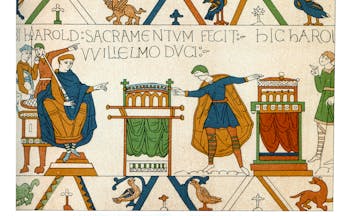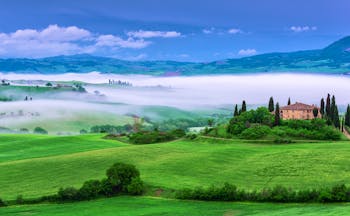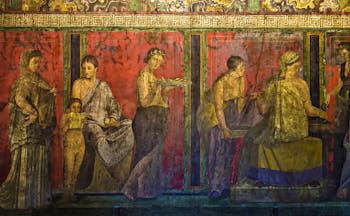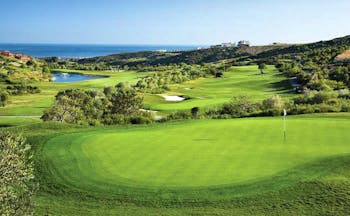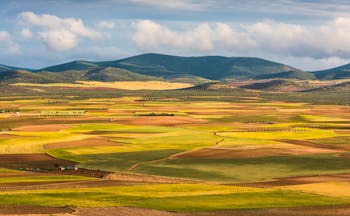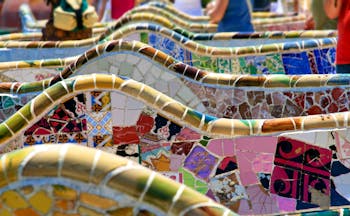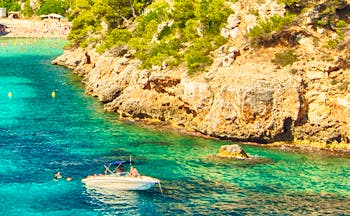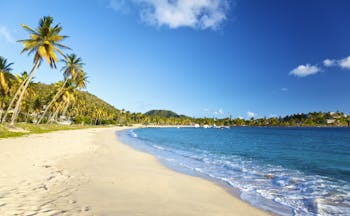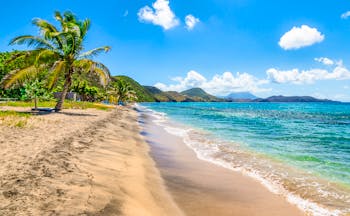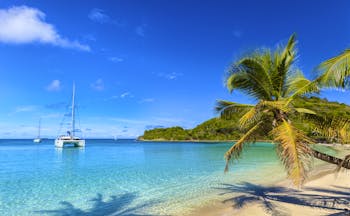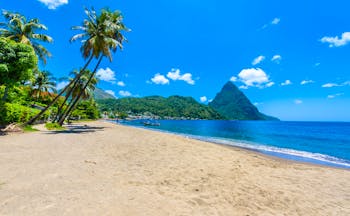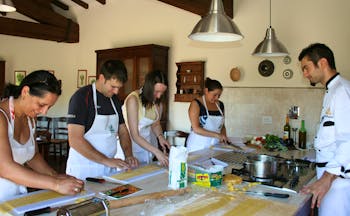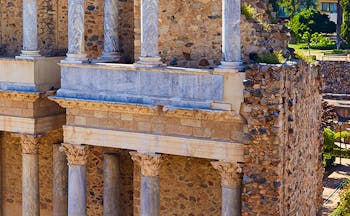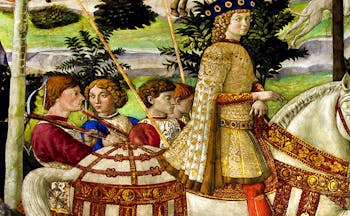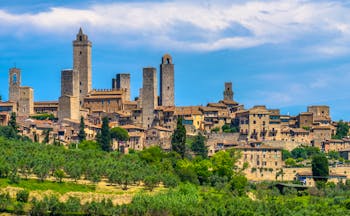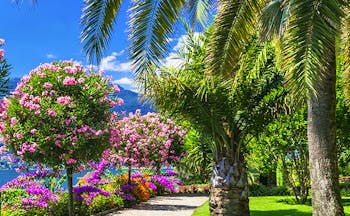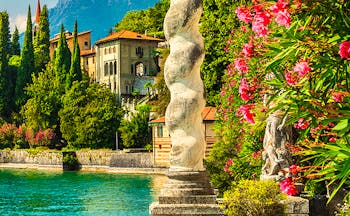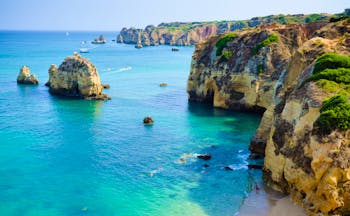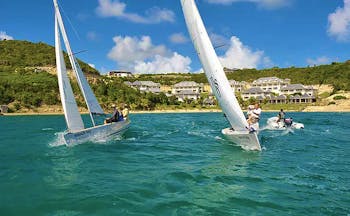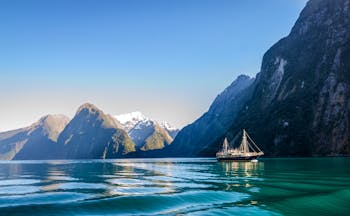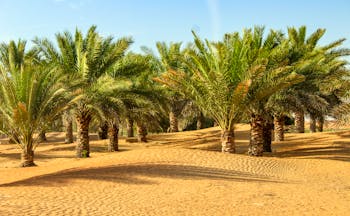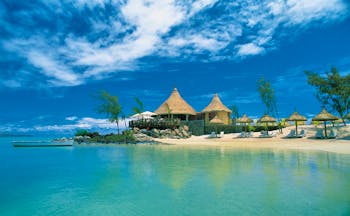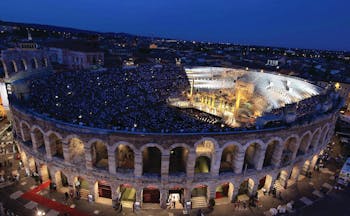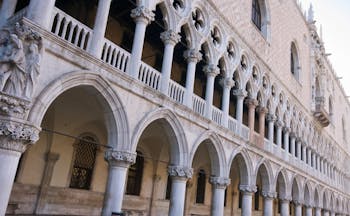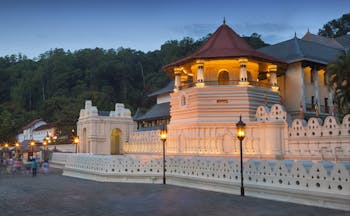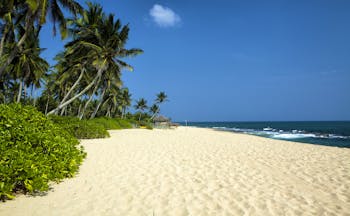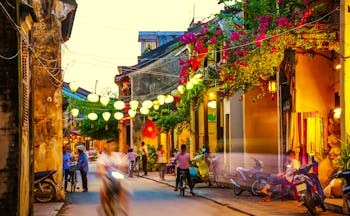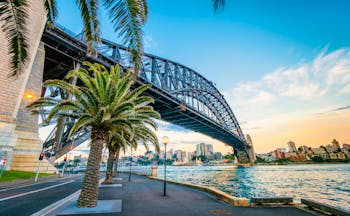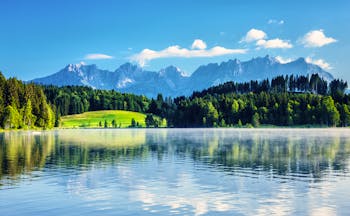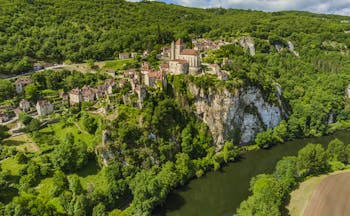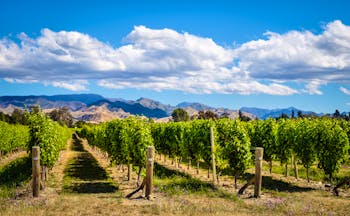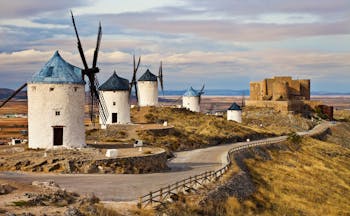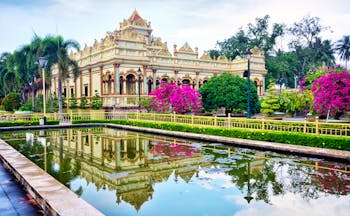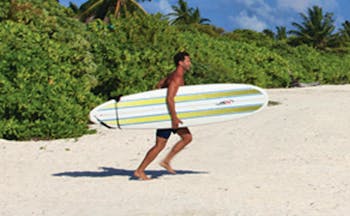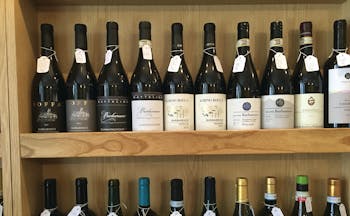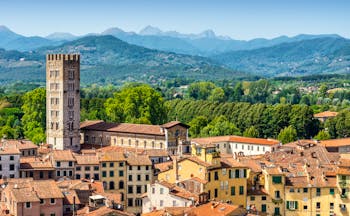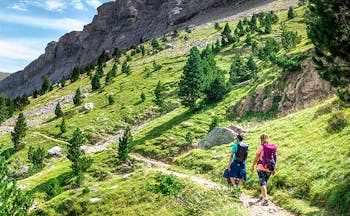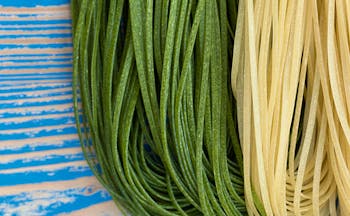Naples to the toe of Italy and Sicily luxury fly-drive tailormade touring holiday
Under the brooding gaze of Vesuvio, begin this luxury fly-drive touring holiday in Naples. Your first hotel sits on the Amalfi Coast's Sorrentine Peninsula, separated from Naples by the mountain and Pompeii. Your hotel in Sant’Agnello is the Grand Hotel Cocumella, a light and airy property with archways that hark back to ancient times. The cliff face that the hotel overlooks appears to cradle the fossils of caves and walls and buildings. Drive south along the coast after three nights in Sant’Agnello, until you reach Maratea, where you still stay for two nights in La Locanda delle Donne Monache. High on the formidable hillsides of Basilicata, Maratea is a small village of immense natural beauty and religious heritage. The Locanda itself is a beautifully converted convent at the peak of the village, affording it an attractive pool terrace with unrivalled views of the town below, the mountains, and the Statue of the Redeemer. Continue south down the side of Italy’s boot to the Villa Paola in Tropea. Spend your days in Calabria exploring this fantastic coastline, hiking across the rocks, and climbing the Isle of Tropea, to see the exclusive stately monastery that sits on top. The final stop on this touring holiday lies across the crystal-clear water on the island of Sicily. You cross by ferry (frequent departures throughout the day) from Villa San Giovanni to Messina, and then it’s about hour by car to Taormina. The Hotel Villa Belvedere in Taormina is a hotel that integrates perfectly into the verdant and florally abundant town in which it sits. Step out on to your own private balcony to bask in the warmth and outstanding views of Sicily, or walk into the centre of town to trace the wealth of Roman and Greek heritage that punctuates the quaint streets. Depart Sicily from Catania to return to the UK on your final day.
Highlights
Sorrento • Chance to visit Capri and Pompeii • Suggested visit of Paestum • Maratea • Tropea • Ferry from San Giovanni to Messina • Taormina • Suggested visit of Etna
Day by day
After arriving in Naples, spend your first day in the city. Embrace the vibrance and uproarious noise, as the rest of this tour will be focused on relaxation. Explore the Gothic Cattedrale di San Gennaro with its charming white façade, the Royal Palace built under Spanish rule still reflected in the intricacy of the interior decoration, the irregular Castel Nuovo, and the extensive Paleo-Christian Catacombs of San Gennaro. The Archaeological Museum is not only a vital insight into the city’s Greco-Roman past and the destruction left by Vesuvio, but is a remarkable pink-hued building in its own right. Your hotel, the Grand Hotel Cocumella, is in the small seaside settlement of Sant’Agnello, which merges with Sorrento to the west. Its coastline rises from the sea in the form of immense grey cliffs, lined with the remains of houses from years ago, with small harbours and marinas stretching out into the sea. For the active visitor, this landscape is ideal for bracing hikes and long walks. Sorrento offers more in the way of historical and tourist attractions. Its historic centre is comprised of a complex network of narrow alleyways, perfect for an afternoon of stimulating exploration, while its famous Piazza Tasso is lined with small cafes ideal for a light lunch. The Chiesa di San Francesco dates back to the 14th century and is adorned with a beautiful, peaceful cloister. Sorrento and Sant’Agnello mark the beginning of the Amalfi Coast, or the ‘Footpath of the Gods,’ with the town of Amalfi itself just an hour’s drive away. Positano, closer to Sant’Agnello than Amalfi, is a similar seaside village of white houses with terracotta roofs built into the tumbling hillside that overlooks the stunning azure sea. The Chiesa di Santa Maria Assunta is a hub of quirky architecture, with its majolica-tiled dome and 13th century Byzantine icon of the Virgin Mary. The Sorrentine Peninsula and the villages of the Amalfi Coast are built on volcanic soil, which enables local producers to create distinctive local wines and olive oil. Stop off at one of the local oil mills or wineries to taste the produce. The Casavecchia wine, for example, dates back to the time of Pliny the Elder and features in his writings, though it was thought to be extinct for a number of years. While in Positano or Amalfi, try the Limoncello, made from the famous Amalfi lemons, or the regional Mozzarella di Bufala, and pick up some of the local speciality ceramics. Choose from the hotel’s three restaurants, and dine either in the fragrant garden, by the poolside, or on the terrace overlooking the sea.
From Sant’Agnello, drive back north to Pompei and take the inland road through Campania to the short coastline of Basilicata. La Locanda delle Donne Monache sits at the very top of the village, with a mountainous backdrop, and was once occupied by nuns. Its religious history can still be observed on the exterior as the building has been faithfully maintained. Explorers of the village will find crumbling buildings and overgrown lanes that hark back to an older Maratea. Follow the flow of these little lanes lined with fractured archways and grottoes, and eat lunch in one of the outdoor cafes on the Piazza Buraglia. Take time to visit most of the 44 churches, each endearingly individual. The most striking is the Chiesetta del Calvario. In the summer the streets come alive with everything from jazz concerts to food tastings, while down at the Maratea Porto, local art is displayed on the walls of the lanes and cafes around the marina. The Grotta delle Meraviglie are a series of atmospheric and mesmerising caves, dripping with stalagmites, and offer another viewpoint from which to see the varied Basilicata landscape. Travel along the shoreline dotted with ruined castles until you reach the small exclusive beaches around Castrocucco, or relax on the La Secca beach or Spaggia Macarro closer to the hotel. Nearby Santa Caterina offers scuba-diving opportunities with the Centro Sub Maratea. High on the peak of Mont San Biagio in the Cliento National Park is Maratea’s answer to the statue of the Redeemer in Rio de Janeiro. It is, however, deliberately more joyful and youthful than its Brazilian counterpart. Reaching 22 metres high, the statue is one of Maratea’s most popular attractions, and certainly worth hiking up to, especially due to the picturesque village nestled on the mountaintop beside it. The hotel’s restaurant, Il Sacello, draws on the traditional flavours of Lucania, and cooking lessons can be organised in advance.
Leave Maratea after breakfast, and drive south along the coast to Tropea. Situated on the Costa degli Dei, or Coast of the Gods, Tropea, and the Villa Paola where you will be staying for two nights, is characterised by its beautiful crystal-clear turquoise waters. Explore this intriguing Calabrian town, perched high up on the fledgling cliffs that line the shore, dining in the hidden squares that belong to the many restaurants, tasting the local seafood, and Tropea’s speciality sweet red onions. This region is also well-known for its hot and spicy food. The headland of this area forms the heart of the town, encased in the remains of the old fortifications. While here, partake in the local tradition of Passeggiata, walking down the Corso Vittorio Emanuele until you reach the metal railings that line the cliff edge as it looks over the sea, and then walking back up and stopping in one of the small cafes. This is an excellent way of getting a feel for Tropea, and the way of life of its residents. For a taste of Tropea’s history, be sure to look around the Norman cathedral, and the Palazzo Vescovile, or Bishop’s Palace, now used as a museum. Various religious festivals happen in Tropea at different times of the year, involving processions through the town carrying the icon of the Madonna of Romania, their patron saint. The crowning glory of Tropea, however, has to be the Santa Maria dell’Isola, a picturesque monastery on a large verdant rock that used to form its own island. Whether you admire this stately building and its position from the high edge of the town, or by climbing up the steps of the rock to capture the magnificent views, the monastery offers an unusual, and beautiful, new perspective on the town. On your second day, you may wish to take a boat trip out into the tranquil waters in the hope of seeing some marine life, or simply to enjoy the sunshine and magnificent surroundings. If you have time on the afternoon of your last day, drive to nearby Capo Vaticano for the watersports opportunities, moonlit cycle rides, and the views from the military lighthouse. Or drive east to the lovely town of Pizzo, rich in local history, with castles, a beautiful town centre, and the Piedigrotta Church, built half into the ground. In the evenings, return to the red façade of the Villa Paola and relax on one of the terraces or in the pool, which, even from its high position, seems to stretch into the sea.
Cross over the short stretch of water that are the Straits of Messina that separate mainland Italy and Sicily, and continue south to Taormina, overlooking the Bay of Naxos. The Hotel Villa Belvedere is situated in one of the greenest parts of Taormina, with a yellow-ochre façade that seems to help it blend in to its floral environment. The rooms are luxurious and chic, and outside are terraces and gardens for you to enjoy before heading out into Taormina to explore its historical delights. Locate the impressive Teatro Antico di Taormina, the second largest Greco-Roman theatre in Sicily, and the source of much local debate as its origins are currently undetermined. Taormina’s history as a Greek Polis does, however, indicate Grecian beginnings. The theatre hosts the Taormina Arte festival, which lasts all summer and features a vibrant abundance of cinema, ballet, theatre, and music. See the influence of Arabian and Norman art on the Gothic Badia Vecchia, formerly Taormina’s abbey, and the Palazzo Duca di San Stefano. Observe the extent of the Arabian influence in the architecture of the Palazzo Corvaja, built in the style of the first temple Abraham built in God’s name. Wander through the Corso Umberto and pick up some of the hand-made ceramics, fine leather, Sicilian wines, and wrought iron and wooden products so prevalent in the area. Stroll around the botanic gardens of Villa Comunale, just a short walk from the Villa Paola, or admire the white-stone medieval Palazzo Ciampoli and its quaint adjacent square. To break up your days of exploration, have a light lunch under the citrus trees that grow by the poolside and the restaurant. One afternoon, drive out to the Alcantara River Park and its gorges, riddled with lava coves and waterfalls. And make the most of the Italian waters on this final stop of your touring holiday, by partaking in the local sports of wind-surfing, sailing, fishing, scuba-diving, canoeing, or snorkelling. Consider also taking a boat trip or hydrofoil to one of the nearby Aeolian Islands, such as Lipari and Salina. One and a half hour’s drive from Taormina is Syracuse, the sight of the largest Greek-Roman theatre in Sicily. The Ortygia, or ‘old town,’ is the home of a beautiful Duomo, the Temple of Athena, extensive catacombs, the Ear of Dionysus, and breath-taking seaside bays, making Syracuse a must-see day-trip for history enthusiasts and those looking for a relaxing day alike. Finish your days by sampling the famous Marsala, Zibibbo, and Primitivo Sicilian wines, or the range of locally-produced liquers, in either the Hotel Villa Belvedere’s restaurant, or in a restaurant in Taormina.
You drive to the airport in Catania, just under an hour from Taormina, return your hire-car and take your flght back to London.
Thanks for organising what was a wonderful holiday. Apart from a delay because of Gatwick fog coming home, everything ran like clockwork and we had a cracking time. I would be happy to recommend Expressions and hope we will have the opportunity to organise another trip with you in the future.Mrs S, October 2024
Holiday price guide Prices from £3,695 per person based on two people sharing a double or twin room.
Holiday Code ITFD02
Call us on 01392 441245
Naples to the toe of Italy and Sicily luxury fly-drive tailormade touring holiday
After arriving in Naples, spend your first day in the city. Embrace the vibrance and uproarious noise, as the rest of this tour will be focused on relaxation. Explore the Gothic Cattedrale di San Gennaro with its charming white façade, the Royal Palace built under Spanish rule still reflected in the intricacy of the interior decoration, the irregular Castel Nuovo, and the extensive Paleo-Christian Catacombs of San Gennaro. The Archaeological Museum is not only a vital insight into the city’s Greco-Roman past and the destruction left by Vesuvio, but is a remarkable pink-hued building in its own right. Your hotel, the Grand Hotel Cocumella, is in the small seaside settlement of Sant’Agnello, which merges with Sorrento to the west. Its coastline rises from the sea in the form of immense grey cliffs, lined with the remains of houses from years ago, with small harbours and marinas stretching out into the sea. For the active visitor, this landscape is ideal for bracing hikes and long walks. Sorrento offers more in the way of historical and tourist attractions. Its historic centre is comprised of a complex network of narrow alleyways, perfect for an afternoon of stimulating exploration, while its famous Piazza Tasso is lined with small cafes ideal for a light lunch. The Chiesa di San Francesco dates back to the 14th century and is adorned with a beautiful, peaceful cloister. Sorrento and Sant’Agnello mark the beginning of the Amalfi Coast, or the ‘Footpath of the Gods,’ with the town of Amalfi itself just an hour’s drive away. Positano, closer to Sant’Agnello than Amalfi, is a similar seaside village of white houses with terracotta roofs built into the tumbling hillside that overlooks the stunning azure sea. The Chiesa di Santa Maria Assunta is a hub of quirky architecture, with its majolica-tiled dome and 13th century Byzantine icon of the Virgin Mary. The Sorrentine Peninsula and the villages of the Amalfi Coast are built on volcanic soil, which enables local producers to create distinctive local wines and olive oil. Stop off at one of the local oil mills or wineries to taste the produce. The Casavecchia wine, for example, dates back to the time of Pliny the Elder and features in his writings, though it was thought to be extinct for a number of years. While in Positano or Amalfi, try the Limoncello, made from the famous Amalfi lemons, or the regional Mozzarella di Bufala, and pick up some of the local speciality ceramics. Choose from the hotel’s three restaurants, and dine either in the fragrant garden, by the poolside, or on the terrace overlooking the sea.
From Sant’Agnello, drive back north to Pompei and take the inland road through Campania to the short coastline of Basilicata. La Locanda delle Donne Monache sits at the very top of the village, with a mountainous backdrop, and was once occupied by nuns. Its religious history can still be observed on the exterior as the building has been faithfully maintained. Explorers of the village will find crumbling buildings and overgrown lanes that hark back to an older Maratea. Follow the flow of these little lanes lined with fractured archways and grottoes, and eat lunch in one of the outdoor cafes on the Piazza Buraglia. Take time to visit most of the 44 churches, each endearingly individual. The most striking is the Chiesetta del Calvario. In the summer the streets come alive with everything from jazz concerts to food tastings, while down at the Maratea Porto, local art is displayed on the walls of the lanes and cafes around the marina. The Grotta delle Meraviglie are a series of atmospheric and mesmerising caves, dripping with stalagmites, and offer another viewpoint from which to see the varied Basilicata landscape. Travel along the shoreline dotted with ruined castles until you reach the small exclusive beaches around Castrocucco, or relax on the La Secca beach or Spaggia Macarro closer to the hotel. Nearby Santa Caterina offers scuba-diving opportunities with the Centro Sub Maratea. High on the peak of Mont San Biagio in the Cliento National Park is Maratea’s answer to the statue of the Redeemer in Rio de Janeiro. It is, however, deliberately more joyful and youthful than its Brazilian counterpart. Reaching 22 metres high, the statue is one of Maratea’s most popular attractions, and certainly worth hiking up to, especially due to the picturesque village nestled on the mountaintop beside it. The hotel’s restaurant, Il Sacello, draws on the traditional flavours of Lucania, and cooking lessons can be organised in advance.
Leave Maratea after breakfast, and drive south along the coast to Tropea. Situated on the Costa degli Dei, or Coast of the Gods, Tropea, and the Villa Paola where you will be staying for two nights, is characterised by its beautiful crystal-clear turquoise waters. Explore this intriguing Calabrian town, perched high up on the fledgling cliffs that line the shore, dining in the hidden squares that belong to the many restaurants, tasting the local seafood, and Tropea’s speciality sweet red onions. This region is also well-known for its hot and spicy food. The headland of this area forms the heart of the town, encased in the remains of the old fortifications. While here, partake in the local tradition of Passeggiata, walking down the Corso Vittorio Emanuele until you reach the metal railings that line the cliff edge as it looks over the sea, and then walking back up and stopping in one of the small cafes. This is an excellent way of getting a feel for Tropea, and the way of life of its residents. For a taste of Tropea’s history, be sure to look around the Norman cathedral, and the Palazzo Vescovile, or Bishop’s Palace, now used as a museum. Various religious festivals happen in Tropea at different times of the year, involving processions through the town carrying the icon of the Madonna of Romania, their patron saint. The crowning glory of Tropea, however, has to be the Santa Maria dell’Isola, a picturesque monastery on a large verdant rock that used to form its own island. Whether you admire this stately building and its position from the high edge of the town, or by climbing up the steps of the rock to capture the magnificent views, the monastery offers an unusual, and beautiful, new perspective on the town. On your second day, you may wish to take a boat trip out into the tranquil waters in the hope of seeing some marine life, or simply to enjoy the sunshine and magnificent surroundings. If you have time on the afternoon of your last day, drive to nearby Capo Vaticano for the watersports opportunities, moonlit cycle rides, and the views from the military lighthouse. Or drive east to the lovely town of Pizzo, rich in local history, with castles, a beautiful town centre, and the Piedigrotta Church, built half into the ground. In the evenings, return to the red façade of the Villa Paola and relax on one of the terraces or in the pool, which, even from its high position, seems to stretch into the sea.
Cross over the short stretch of water that are the Straits of Messina that separate mainland Italy and Sicily, and continue south to Taormina, overlooking the Bay of Naxos. The Hotel Villa Belvedere is situated in one of the greenest parts of Taormina, with a yellow-ochre façade that seems to help it blend in to its floral environment. The rooms are luxurious and chic, and outside are terraces and gardens for you to enjoy before heading out into Taormina to explore its historical delights. Locate the impressive Teatro Antico di Taormina, the second largest Greco-Roman theatre in Sicily, and the source of much local debate as its origins are currently undetermined. Taormina’s history as a Greek Polis does, however, indicate Grecian beginnings. The theatre hosts the Taormina Arte festival, which lasts all summer and features a vibrant abundance of cinema, ballet, theatre, and music. See the influence of Arabian and Norman art on the Gothic Badia Vecchia, formerly Taormina’s abbey, and the Palazzo Duca di San Stefano. Observe the extent of the Arabian influence in the architecture of the Palazzo Corvaja, built in the style of the first temple Abraham built in God’s name. Wander through the Corso Umberto and pick up some of the hand-made ceramics, fine leather, Sicilian wines, and wrought iron and wooden products so prevalent in the area. Stroll around the botanic gardens of Villa Comunale, just a short walk from the Villa Paola, or admire the white-stone medieval Palazzo Ciampoli and its quaint adjacent square. To break up your days of exploration, have a light lunch under the citrus trees that grow by the poolside and the restaurant. One afternoon, drive out to the Alcantara River Park and its gorges, riddled with lava coves and waterfalls. And make the most of the Italian waters on this final stop of your touring holiday, by partaking in the local sports of wind-surfing, sailing, fishing, scuba-diving, canoeing, or snorkelling. Consider also taking a boat trip or hydrofoil to one of the nearby Aeolian Islands, such as Lipari and Salina. One and a half hour’s drive from Taormina is Syracuse, the sight of the largest Greek-Roman theatre in Sicily. The Ortygia, or ‘old town,’ is the home of a beautiful Duomo, the Temple of Athena, extensive catacombs, the Ear of Dionysus, and breath-taking seaside bays, making Syracuse a must-see day-trip for history enthusiasts and those looking for a relaxing day alike. Finish your days by sampling the famous Marsala, Zibibbo, and Primitivo Sicilian wines, or the range of locally-produced liquers, in either the Hotel Villa Belvedere’s restaurant, or in a restaurant in Taormina.
You drive to the airport in Catania, just under an hour from Taormina, return your hire-car and take your flght back to London.
Thanks for organising what was a wonderful holiday. Apart from a delay because of Gatwick fog coming home, everything ran like clockwork and we had a cracking time. I would be happy to recommend Expressions and hope we will have the opportunity to organise another trip with you in the future.Mrs S, October 2024
Holiday price guide Prices from £3,695 per person based on two people sharing a double or twin room.
Holiday Code ITFD02
Our prices include
● British Airways flights in economy from Gatwick to Naples, and Catania to Gatwick
● Hire of a group B car for the duration of your holiday
● 3 nights’ bed and breakfast in a Classic double room at the Grand Hotel Cocumella, Sant’Agnello near Sorrento
● 2 nights’ bed and breakfast in a Classic double room at La Locanda delle Donne Monache, Maratea
● 2 nights’ bed and breakfast in a Superior double room at the Villa Paola, Tropea
● 5 nights’ bed and breakfast in a Double room with French balcony and sea view at the Hotel Villa Belvedere, Taormina
● Concierge service and Expressions Holidays regional helpful hints
Our prices do not include
● Early check-in or late check-out at any hotels (although we can arrange this on request at additional cost)
● Any other services not mentioned above, such as transfers and meals except breakfast at hotels
● Personal holiday insurance. This is essential and cover should be in place from when you book the holiday.
● Local tourist tax, usually between Euros 1 and 3 per person per night, and payable locally to the hotel
● Not included is the ferry ticket from Villa San Giovanni to Messina which you can buy at the port or ask us to buy it for you as soon as you know the registration number of the hire-car.
Additional information
Driving times for this touring holiday
Naples to Sant’Agnello 1 hour
Sant’Agnello to Maratea 2 hours 45 minutes
Maratea to Tropea 3 hours 5 minutes
Tropea to Taormina 2 hours 55 minutes
Taormina to Catania 45 minutes
Call us on 01392 441245
Naples to the toe of Italy and Sicily luxury fly-drive tailormade touring holiday
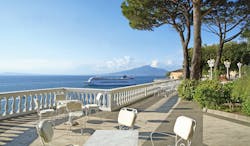
The Grand Hotel Cocumella is a luxury 5-star boutique hotel in a beautiful coastal location. The gourmet cuisine and beautiful parks and gardens afford guests a truly tranquil and indulgent experience.
Classic double room
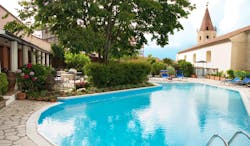
La Locanda delle Donne Monache is a 4-star boutique hotel with breath-taking views of the rugged rural surrounds. Located in a former monastery, the hotel is steeped in history and affords guests a truly relaxing and restorative experience.
Classic double room
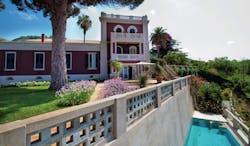
Villa Paola is an exclusive 5-star historical hotel with beautiful coastal views. Both the beach and hotel pool offer sunbathing opportunities and the surrounding rural area is perfect for walks and exploration. A truly relaxing and restorative retreat.
Superior double room
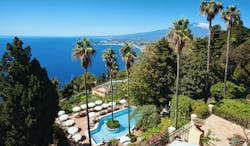
Hotel Villa Belvedere is a delightful 4-star hotel boutique hotel with enchanting views of Mount Etna and the sea. The beautiful gardens and idyllic terrace make it an ideal spot to relax and recuperate after exploring historic Taormina.
Double room with French balcony and sea view
Thanks for organising what was a wonderful holiday. Apart from a delay because of Gatwick fog coming home, everything ran like clockwork and we had a cracking time. I would be happy to recommend Expressions and hope we will have the opportunity to organise another trip with you in the future.Mrs S, October 2024
Holiday price guide Prices from £3,695 per person based on two people sharing a double or twin room.
Holiday Code ITFD02
Call us on 01392 441245
Naples to the toe of Italy and Sicily luxury fly-drive tailormade touring holiday
About Amalfi Coast
An Expressions tailor-made holiday to the Amalfi Coast is perfect for those looking for relaxation as well as sightseeing in coastal towns such as Amalfi, Positano, Ravello and Sorrento on the Amalfi Coast as well as the islands of Capri and Ischia. The Amalfi Coast is best known for its dramatic coastal scenery, deep gorges and violently-shaped rocks that plunge into a deep blue sea, tempered by the luxuriant vegetation that thrives in the favourable climate; lemons, oranges, olives, almonds, vines, camellias and bougainvillaea. Human habitation thrives in the tiny fishing villages in rocky coves and in the pink and white-washed flat-roofed or domed buildings that hug the cliffs in layers. The Amalfi Coast's history of trading throughout the Mediterranean still shows in the Moorish and Byzantine architectural styles; domes and arcades, wrought-iron balconies and colourful ceramic tiles which depict the region. The cuisine of the Amalfi Coast is light and simple, based on local fish and shellfish, lemons and oranges, mozzarella and fresh herbs. Whilst the climate of the Amalfi Coast is particularly appealing too, there are numerous excursion and sightseeing possibilities for your holiday including the islands of Procida, Capri and Ischia, the city of Naples, the Roman towns of Pompeii and Herculaneum, the romance of Ravello, the bustle of Sorrento and the charm of Positano.
Highlights of the Amalfi Coast
A drive along the Amalfi coast from Positano to Amalfi offers stunning and breath-taking scenery. Visit the Emerald Cave near Vettica Minore by boat. Enjoy the superb view of the coast from the 13th Century Gothic Villa Rufolo in Ravello (we offer garden tour holidays of the Amalfi Coast and Capri including a visit to Villa Rufolo). Spend a full day visiting the awe-inspiring site of Pompeii, visiting the remains of the villas containing both vibrant and delicate frescoes. Herculaneum is nearby and also worth visiting. The Greek site of Paestum has outstanding Doric temples. In the resort of Amalfi stroll along the Via Genova and the Via Capuano taking in the typical architecture of Campania with the flower-covered balconies, narrow alleyways leading to fountain-filled little squares. Take the chairlift on Capri to Monte Solaro or walk to the Migliara Belvedere for a view of the lighthouse. On Ischia visit the beaches of Citara and Maronti and enjoy a morning's walk to Monte Epomeo for panoramic views of the coast. Well worth visiting is the often-forgotten island of Procida between Naples and Ischia, with its vines and fishing, flat roofed white houses and atmosphere most characteristic of the region in bygone days. Visit Vietri for ceramics as well as stalls of lemons, garlic and peppers.
Cultural highlights of the Amalfi Coast
The House of the Vettii at Pompeii, the baroque Palazzo Reale at Caserta, Villa Jovis in Capri, the Doric temples of Paestum, Michelozzo`s tomb of Cardinal Rinaldo Brancaccio in the 14th Century church of Sant`Angelo, and in Naples: `Modesty` by Antonio Corradini in the Cappella Sansevero, the Gothic church of San Lorenzo Maggiore and the Majolica tiles in the cloisters of the 14th Century Santa Chiara.
Festivals on the Amalfi Coast
The Ravello music festival June to July, the festival of San Costanzo on 14 May on Capri, the festival of Sant`Antonio in Anacapri on 13 June, the festival of Madonna della Liberta in Marina Grande in September, Lo Sbarco dei Saraceni in Positano on the second Sunday in August.
Gastronomy of the Amalfi Coast
Neapolitan cuisine is now famous the world over for its use of tomatoes, pizza, mozzarella cheese, dried pasta and lemons. Local specialities include Mozzarella in Carrozza, Panzanella alla napoletana, Pasta alla sorrentina (with scamorza cheese and tomatoes), Sartu (an elaborate rice pie stuffed with meats, sausages, mushrooms etc), Timballo di Maccheroni (also elaborate with maccheroni baked in a pie and a sauce of chicken livers, mushrooms and black truffles), Carciofi ripieni alla napoletana (baked stuffed artichokes), Coviglie (a mousse-like dessert), Sproccolati (sun-dried figs on sticks) and Sfogliatelle (breakfast pastries). The region produces a number of excellent red and white wines. The most famous white is called Lacrimi Christi, from vines grown on the slopes of Mount Vesuvius. Taurasi from Avellino is a full-bodied red. Capri, Ischia and Sorrento all produce their own local wines.
Call us on 01392 441245
Naples to the toe of Italy and Sicily luxury fly-drive tailormade touring holiday
About Basilicata
An Expressions tailor-made holiday in Basilicata is an opportunity to explore a little-known area of the country. If Calabria is Italy's toe and Puglia its heel, then Basilicata is the elegant, intoxicating instep. Home to a magnificent legacy of architectural splendours reflecting its prosperous past, and peppered with breathtakingly beautiful coves and long, sandy bays, as well as a rugged, unspoiled mountain interior that makes for fabulous walking, Basilicata is one of Italy's most rewarding yet unsung destinations. With coastlines on both the Tyrrhenian and Ionian Seas, Basilicata has been heavily influenced by visiting Greeks and Lombards, Byzantines and Normans, but has been relatively neglected by holidaying visitors in recent years. Sprinkled with a clutch of gorgeous beach resorts and hotels, the temptation in Basilicata is just to relax. However away from the beach the region offers huge rewards, with a rugged, remote sparsely populated interior with craggy, arid plateaux of pine and beech, terraces of chestnut and oaks, studded with sparkling lakes - it's Italy from another time and age, with leafy, cobbled village squares where you could sip cappuccinos all day long, watching the ancient pace of village life play out around you. Rich in archaeological relics, Basilicata has Greek ruins at Metaponto, while ruins of the Roman Age can be seen in Venosa. Mediaeval art also abounds, with the churches in Venosa and Cerenza particularly impressive. Architecturally, the region bears traces of many fascinating, contrasting influences, with Matera, Melfi and Lagopesole rich in Arab-Byzantine and French influences, while Neapolitan Baroque influences also abound. Finally, wherever you venture in Basilicata, eating out is a hugely enjoyable aspect of local life. Here in this arid land, gastronomy is based on traditional, strong, sharp and sun-filled flavours, washed down with rich and full-bodied reds. Basilicata is an excellent destination for those who wish to discover fascinating architecture as well as to relax in beautiful surroundings.
Highlights of Basilicata
In Matera, the 13th century cathedral houses the 12th century Madonna della Bruna, while Santa Maria di Idris has 13th century frescoes; also in Matera, visitors can see the “Sassi”, the typical houses and churches dug into the “tufa” crag; the May “chopping festival”, played out in villages right across the region; Sunday markets selling the region's famous ceramics, as well as traditional foods such as spicy sausage and fresh game; the Antiquarium of Metaponto; breath-taking views from the summit of Monte Biagio above Maratea, crowned by a huge statue of Christ the Redeemer; Potenza has some beautiful Romanesque churches and a wonderful 12th cathedral, and is a fascinating regional capital, at 2,687ft above sea level, Italy's highest. A visit to the region is also an opportunity to try local cuisine, with Basilicata particularly known for strong, rustic flavours, such as roast kid with potatoes, peas and artichokes and provolone from Sila.
Call us on 01392 441245
Naples to the toe of Italy and Sicily luxury fly-drive tailormade touring holiday
About Calabria
An Expressions tailor-made holiday to Calabria offers a traditional, magical glimpse of Italy that few visitors get to see. Historically one of Italy's poorest regions, Calabria - the toe of Italy - is a startlingly dramatic place, peppered with stunning hilltop towns that seem to grow right out of the rugged, craggy mountaintops. Formerly the site of rich and powerful Greek settlements, Calabria today is scattered with impressive ruins, and even shelters the odd Greek-speaking village and Albanian communities dating back over 500 years. But historically fascinating as the regions is, its great ancient cities such as Magna Graecia have all but disappeared, vanquished by centuries of fighting and conquest, malaria and earthquakes. Today, it is the region's nearly 500-mile coastline that attracts most visitors, with wonderful, wide beaches and secluded coves lapped by the Tyrrhenian and Ionian Seas. Inland, Calabria offers superb scenery for walkers and explorers, particularly around La Sila, a breathtakingly dramatic, high-level plain with lakes, snow-capped summits and ancient woodland. Here you'll be able to admire the giganti della Sila, trees which are over 500 years old, six feet across and 130 feet tall, or ride the unforgettably panoramic narrow-gauge railway between Cosenza and San Giovanni in Fiore. A remote land, Calabria is full of unexpected beauty, and wherever you stay here, a drive down the south coast to Capo Colonna is a must. Here, formerly the site of a temple to Hera known throughout the ancient land, a single column sitting at the very edge of the Ionian Sea stands as a devastatingly haunting, wildly romantic metaphor for the entire region.
Highlights of Calabria
Cosenza, the largest town in Calabria, with a magnificent 12th century Norman hilltop castle and cathedral, and a beautiful, cobbled Old Town centred round picturesque Piazza XV Marzo; the serene cloisters of San Domenic chapel in Cosenza, and the 13th century San Francesco d'Assisi church; Camigliatello, a classic alpine village, and best base for exploring La Sila, especially the 130ft high, 500-year old pines in Bosco di Fallistro; the village of Taverna, where the church of San Domenico houses seven paintings by Calabria's most famous artist, Mattia Preti; the dramatic, superbly scenic narrow-gauge railway between Cosenza and San Giovanni in Fiore; the hill town of Caccuri, built around a restored castle; the museum at Reggio Calabria, housing a superb collection of Greek and Roman sculptures and artefacts; the seaside resort of Tropea, famous for its delicious red onions, and a 20-mile beach stretches all the way from Pizzo up to Capo Vaticano; the beaches of Scilla; the passeggiatta at Amantea, a lovely seaside town with lively nightlife; Pizzo, whose intimate central piazza, hemmed in by ancient houses, is a superb spot to sit and enjoy the local delicacy of black truffle ice cream.
Call us on 01392 441245
Naples to the toe of Italy and Sicily luxury fly-drive tailormade touring holiday
About Sicily
An Expressions tailor-made holiday in Sicily allows visitors to discover a unique and captivating island. The rich tapestry of Mediterranean history can be witnessed on the southerly island of Sicily, fascinating not only for its amazing blend of cultures including Greek, Arab, Byzantine and Norman and its architectural treasures which reflect these influences but also for its breath-taking scenery of coast, parched mountains and fertile groves of almonds, oranges, lemons and olives. The people are proud and independent, reserved but sincere and helpful. Traditions thrive to an extent that the atmosphere of Sicily is unrecognisable in the context of other parts of Italy further north. The towns and villages are contrasting with picture postcard scenes of mediaeval labyrinthine alleyways adorned by wrought-iron balconies and baskets of flowers or severe dilapidation punctuated by grand Baroque or austere Norman cathedrals and churches. Additionally, there are of course some of the most important sites of the ancient Greek world such as the temples at Agrigento, the theatre at Taormina and numerous relics at Siracusa, reputedly one of the most beautiful cities of the Greek world. High above the island looms Mount Etna, one of the largest volcanoes in the world and an awe-inspiring sight. Off the north coast of Sicily, the beautiful Aeolian Islands offer escape and remoteness, natural scenery and a startling light, a sleepy way of life and romantic isolation. A holiday in Sicily appeals for those who want typical rest and relaxation with cultural activities at hand, and for those who want to be more adventurous and experience more of this captivating island.
Highlights of Sicily
An ascent of Mount Etna, partly by car and then further on foot (guides available) through the luxuriant vegetation which includes oranges and lemons, bougainvillaea and poinsettias and then higher up the groves of walnuts, cherries, almonds, pistachios and vines. Palermo is known for its street markets, especially Vucciria and Ballaro, where traders and hawkers, pickpockets and shoppers converge amongst narrow streets and stalls of wares. See the traditional costumes and dialect of Piana degli Albanesi, where Albanians settled in the 15th Century. Revel in the splendid site of Taormina above the sea with views to Etna. Local crafts include cork, ceramics, honey, embroidery, raffia. Enjoy the calm and remoteness of the Aeolian Islands with their clear waters, beautiful scenery and peaceful way of life. Enjoy the gardens of the Villa Giulia in Palermo and the Public Gardens in Taormina.
Cultural highlights of Sicily
Palermo contains some of the greatest Arab-Norman buildings in existence - San Giovanni degli Eremiti, the Palazzo Reale with its striking Cappella Palatina and La Martorana. Monreale outside Palermo is the greatest work of Norman architecture in Sicily and contains beautiful 12th and 13th Century mosaics and cloisters. The Doric temples of the 5th Century BC in the Valley of the Temples in Agrigento. Cefalu has the `Portrait of a Man` by Antonello da Messina, dating from 1465 in its Museo Mandralisca.
Festivals in Sicily
Many Sicilian local festivals are linked to Saints’ Days. A few of the most well-known festivals generally include Carnival celebrations in Taormina and Acireale. Easter is celebrated especially in Trapani, Marsala and Piana degli Albanesi. Messina celebrates Ferragosto on the 15th August with a firework display over the Straits. The Sagra del Mandorlo in Fiore takes place in Agrigento in the first and second weeks of February to celebrate the almond blossom. Taormina Arte is a summer festival of music, cinema, ballet and theatre, held in the Greek theatre. The Palio dei Normanni takes place in Piazza Armeria in August.
Gastronomy in Sicily
The gastronomy of Sicily, like much of the culture of the island, has been heavily influenced by its history. Cuscus is a Sicilian version of couscous, and marzipan features heavily in sweets. Local produce includes citrus fruits, almonds, capers, olives, peppers and fish. Local specialities include Maccheroni con le sarde (pasta with sardines, fennel, raisins, pine nuts and saffron), Pesce spada (grilled sword fish), 'alla Siciliana' with capers, red peppers and herbs. Cassata is a popular dessert made with ricotta, candied fruit and pistachios and Cannoli are almond biscuits stuffed with ricotta. Sicily produces a variety of red and white wines including Corvo di Salaparuta and Etna, Marsala and Malvasia.

